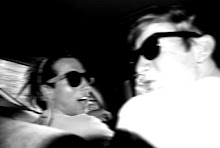Things have become real for me. And it’s made me quite dizzy. The past week has taken my grandiose theoretical opinions/dreams/ideas and placed them directly under the big yellow bus of the real experience. It’s chizi comma ndizi (crazy like a banana).
On Friday, we visited a non-governmental organization in Eastern Nairobi that helps women living with or directly affected by HIV/AIDS. Part of the organization’s work was to provide counseling through home visits to women enrolled in the program. A staff member and four of us visited a young mother who was staying at her mother’s home. I’d rather not lay out the circumstances, but what it came down to was this: within the past two weeks, an elderly mother had found out that two of her daughters and a granddaughter were HIV positive. And there we were talking with them about it in their one-room home. Talk about intrusive.
My ideas of what it means to have HIV/AIDS and what the disease was all about suddenly took on an altogether human look. My ideas about how to design an effective free-ART (antiretroviral therapy) public health program were cut to shambles. This young mother and her 15-month old baby could not get started on the free ART meds from the federal government because they were both too weak from TB. They had fallen through the cracks of a theoretically amazing HIV/AIDS program. And the reality of the matter is that many people, especially young women, do not get tested until they become very ill. Stigma sucks. If they find out that they are HIV positive they cannot get started on the ART meds because they are too sick from whatever brought them to get tested in the first place. The government plan, most of it funded through USAID programs, was failing this family.
On Saturday, we traveled across town to help with a trash clean-up project designed by a very large non-governmental organizations in the slums of Mathere. This organization promoted youth soccer teams in the community and integrated community service by requiring that every soccer team volunteer for x number of hours in order to be in the league. On paper, it seems like a decent idea, but when it came to the actual clean up, all chaos broke loose. The slums of Mathere are home to a massive amount of trash because Kenya lacks a public waste management system. For an hour and a half, with a team of about 100 youth soccer players and random kids, we attempted to put a dent in this mass of used everything.
Imagine if the surface of Mars was covered in trash of all sorts, some of it burning with a thick black smoke. Throw in a few goats, mzungus (white peeps), and some soccer players. Shazam! You’ve got the product of our hard work. I simultaneously wanted to photograph the scene and felt a sense of disgust that I even had the urge to “aim and shoot”. The whole photography deal has really been nagging me here. To me, the trash clean up scene was a landscape altogether foreign to me. Yet there were homes situated right across the street from the huge trash piles, so what right did I have to capture the dramatic poverty of someone’s life in a photograph? I had no relationship with the environment and the people living in it, and therefore no legitimate reason to photograph anything. I was just this advantaged kid who traveled all the way across the pond to visit this way of life. I could leave the smoke and smell whenever I wanted. But I also really wanted to take some pictures. Photography, I’ve found, is much like an anthropological field study.
Those feelings were exacerbated the next day when one my friend’s host mothers agreed to take us on a walk through the Kibera slums. Walking along the railroad tracks surrounded by hundreds of tin-roofed shops and homes was a very intense experience. Everything is sooooo close. Where people sleep, eat, poop, and threw their trash all seemed to be in the same place. Cramming to the utmost degree.
These real experiences have challenged and complicated my own ideas, perceptions and beliefs about development and the global village. But they also make me think of a phrase I once saw masterly spray-painted on some plywood. It goes something along the lines of; “the hope of a different world shapes how we view today.” There is an opportunity for a different social order, a different paradigm of development, a different whatever.
So, I can feel helpless and disheartened by the realities I’ve experienced, but I can also imagine the possibilities of what could be. And I can run into Victor and Bridget, two neighborhood kids who will find any reason to burst into uncontrollable laughter. Or I can walk through the market and stop to talk with someone who sells vegetables. After a few minutes, maybe I can ask to take a photograph of them. I can also see the vibrancy of life that emanates from the streets of Kibera. And I can see the amazing work of my host mother, who will take in and support anyone struggling with HIV/AIDS. I can see the hope and hard work of Kenyans dreaming of a different world.
Tomorrow, I’ll be traveling to the Eastern coast for two-weeks and will be unable to access the information superhighway. We’ll be staying with families in a rural town called Shirazi, chilling with the Islamic community in Mombasa, and maybe throwing some disc on the beach. Take it easy until next time, and let me know what hooliganisms you’ve gotten into.


No comments:
Post a Comment